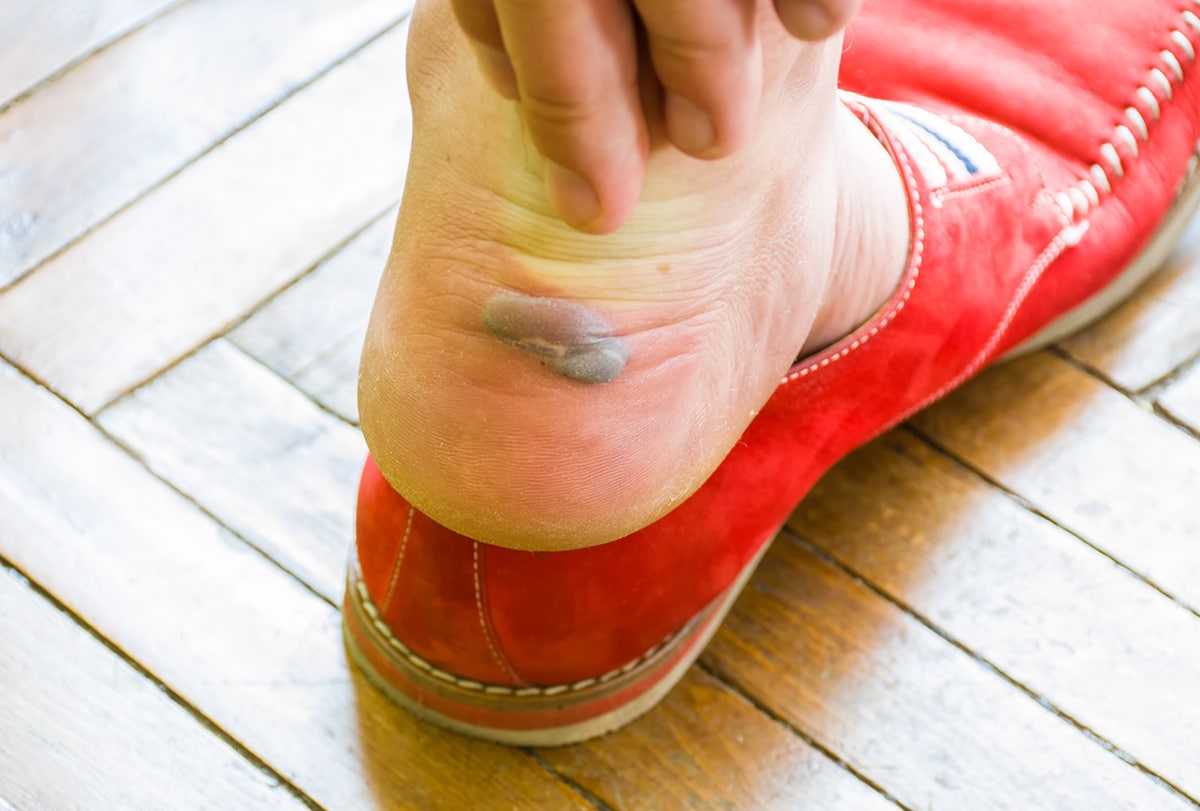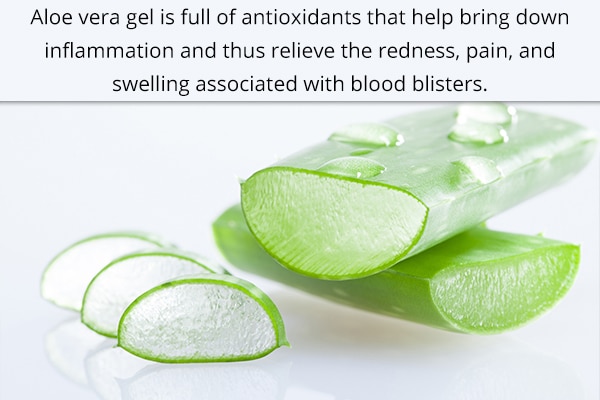Friction blisters are soft raised fluid-filled lesions that form when an area of the skin undergoes repeated friction or strain for prolonged periods. The constant physical trauma makes the outermost layer of the skin separate from the underlying layers.

The body responds to this injury by triggering inflammation in the area and forming pockets of pus between the separated skin layers. In some cases, the damage is severe enough to rupture the small blood vessels in the area, causing blood to pool inside the blister. The resulting blister is then called a blood blister instead of a friction blister. (1)
Home Remedies for Blood Blisters
Here are some home remedies to treat blood blisters that occur on the hands and on feet:
1. Apply an ice pack
Applying a cold compress to the blood blister can make it hurt less, and this is often used as a first-line intervention for the condition.
The topical cold numbs the underlying nerves to make you feel less pain, but this effect only lasts for a short period. The cold application also constricts the underlying blood vessels to reduce blood flow in the area, making the swelling go down.
How to use:
- Wrap one or two ice cubes in a soft and clean towel or washcloth to make an ice pack.
- Gently place it on the blister, no more than 10 minutes at a stretch, without applying any pressure.
- Do this repeatedly as needed, but with short intervals between consecutive applications. (2)
2. Use aloe vera gel

Aloe vera gel is full of antioxidants that help bring down inflammation and thus relieve the redness, pain, and swelling associated with blood blisters. These antioxidants also help repair the damaged skin and make the blister heal faster.
Plus, aloe gel exhibits potent antimicrobial activity that can help keep infections at bay. (3)
How to use:
- Cut open a fresh aloe vera leaf to extract its gel.
- Apply the gel over the blister 2–3 times a day or as needed.
3. Try using green tea
Green tea is credited with strong anti-inflammatory and wound-healing properties that can be traced back to its rich antioxidant content. (4)(5) Applying it to blood blisters can ease the pain and swelling while also accelerating skin repair.
How to use:
4. Rinse with Epsom salt
Epsom salt is mainly composed of magnesium sulfate along with some other minerals.
This compound works as a powerful anti-inflammatory agent that can help dry out your blood blister. It reduces the redness, pain, swelling, and fluid accumulation, making the lesion less discomforting while also promoting speedy healing.
How to use:
- Mix 1 teaspoon of Epsom salt in 1 cup of warm water until it is fully dissolved.
- Use this saline solution to thoroughly rinse the blister and the skin around it.
- Do this two to three times daily until the blister goes away completely.
5. Using apple cider vinegar can help
Apple cider vinegar is a mild acid that helps dry out your blister to facilitate fast healing. It also possesses antimicrobial effects that help keep the blister from getting infected. (6)
How to use:
- Dilute 1 teaspoon of ACV with an equal amount of water.
- Soak a cotton pad in this mixture and place it over the blood blister.
- Leave it on for 10–15 minutes.
- Do this twice a day.
Causes of Blood Blisters
Blood blisters, like friction blisters, usually appear on the feet and hands since they are the most overused parts of the body.
Your feet carry you around and remain buried under the load of the body. Plus, they constantly rub against your footwear while walking or running about.
Meanwhile, your hands are needed to hold, operate, and lift things, making them susceptible to friction and strain. The skin over the hard bony areas is stretched out thin and therefore gets damaged more easily, whereas the soft fleshy areas are better at absorbing the pressure, which makes them less prone (but not immune) to blistering.
People usually get them on their fingers, palm, back of the heel, upper side of the toes, and periphery of the foot. (7)
Some common factors that lead to the formation of blood blisters are:
- Physically demanding activities such as hiking, dancing, and running
- Standing or walking for long periods
- Severe pinching of the skin (8)
- Handling hard and heavy tools such as a rake, a shovel, a pick, sports gear, and gym equipment (7)
Symptoms Accompanied With Blood Blisters
Blood blisters are characterized by the following:
- Severe pain when they first develop
- Same size and shape as normal friction blisters but tend to be darker because of the blood trapped inside (9)
- Itching
- Fever, body pain, or fatigue if they are caused by systemic factors such as infection rather than friction or strain
Treatment Modalities for Blood Blisters
Blood blisters don’t need to be treated medically and tend to heal on their own within 1–2 weeks. (9) But you can cover the lesion with a bandage to protect it from dirt, germs, and further injury while it heals.
Use adhesive bandages for smaller blisters and moleskin bandages for larger, more raised ones. Moleskin bandage can also be used to cushion the blisters that form on high-pressure areas such as the soles of the feet.
It’s best to apply an adhesive bandage on top of the moleskin bandage for extra padding and protection. (8)
If the blister ruptures, wash the area with warm water and mild soap, smoothen the remaining flap of skin, let it air-dry, apply an antibiotic cream, and loosely cover it with a sterile bandage or gauze.
If the blister is too big or painful or located at a tricky spot, you can get it drained by a doctor. Some people choose to do this at home, but it requires a lot of caution and precision to avoid further tissue damage.
Preventive Tips Against Blood Blisters
Follow these self-care measures to reduce the risk of blister formation: (10)
- Wear properly fitting shoes and socks to minimize friction against the feet.
- Avoid pure cotton socks as they absorb sweat and moisture, which increase the risk of blister formation. Instead, choose acrylic, woolen, nylon, or polyester socks that wick moisture away from the skin to keep your feet dry and less prone to blister formation.
- If you are going for a run, apply an antichafing stick to your feet to minimize friction.
- Wear two layers of socks while running to provide extra padding to your feet. This will ensure that friction occurs between the overlapping layers of socks and will keep the foot from rubbing against the sock. (11)
When to See a Doctor
Blood blisters are benign, self-resolving lesions that generally don’t warrant a visit to the doctor. But you may have to seek medical help if the blister:
- Is too large or painful
- Develops on an awkward spot
- Turns more swollen, painful, sore, and red with time, all of which are signs of infection
- Persists or gets worse despite proper care and treatment (12)
Most-Asked Questions About Blood Blisters
How long does it take for blood blisters on the feet to disappear?
It usually takes about 7–14 days for a blood blister to subside, but the discoloration may take longer to go away completely.
The skin gradually sheds its damaged outer layer and new healthy skin rises to the surface to replace it. But it takes 30–48 days for the entire epidermis to get regenerated this way, so that’s the estimated time for the complete disappearance of the blister.
One way to speed up the healing process and make sure the blister does not come back is to rest the affected area and protect it from further strain and friction while it heals. If you don’t do that, the blood blister will take longer to heal and may even recur.
Should I pop my blister?
No, squeezing, popping, or applying excess pressure to the blister can lead to deep tissue damage, which can take longer to heal and may leave behind a scar. It can also injure the surrounding skin and transfer germs to the wound, causing an infection.
If the blister is already infected, popping it will spread the infection deeper into the skin and to the surrounding area. So it’s best that you leave the blister alone and let it heal on its own.
How are blisters diagnosed?
Doctors can typically diagnose blood blisters by visually examining the lesion.
Final Word
Blood blisters are pretty common and harmless but can cause a lot of discomfort while they persist. The above-mentioned interventions can help soothe the pain and inflammation associated with these lesions while also promoting fast skin healing and reducing the risk of infection.

